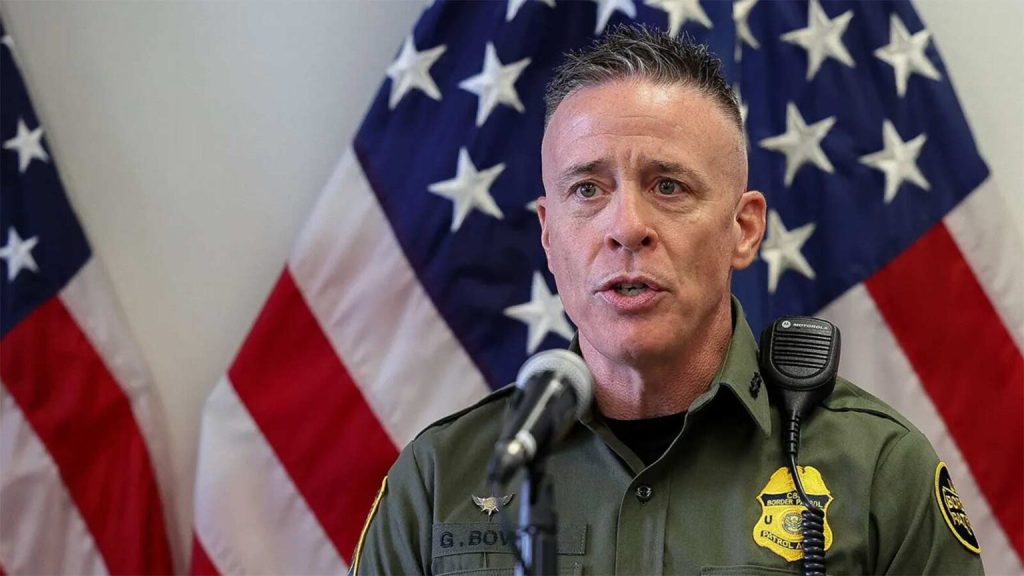Gregory Bovino, a senior Border Patrol official, has become a central figure in recent U.S. immigration enforcement controversies. As the chief patrol agent of the El Centro Sector and a key player in the Trump administration’s Operation Midway Blitz, Bovino has drawn both praise and criticism for his leadership during high-profile immigration sweeps in cities like Chicago and Los Angeles. His testimony in a federal lawsuit over alleged abuses by ICE and CBP has sparked nationwide debate about the balance between national security and civil rights.
The Legal Battle Over Immigration Enforcement

In October 2025, a federal judge ordered Gregory Bovino to testify in a case involving allegations of excessive force, warrantless arrests, and the use of tear gas during immigration enforcement operations in Chicago. This marks a significant moment in U.S. immigration law, as it is the first time a sitting Border Patrol chief has been compelled to appear in court over domestic enforcement tactics.
Why Bovino’s Testimony Matters
Bovino’s deposition is a critical part of the legal proceedings, with plaintiffs—including journalists, clergy, and immigrant advocates—alleging that ICE and CBP officers used excessive force, violated a consent decree, and conducted arrests without valid warrants during mass enforcement sweeps in the Chicago area. If proven, these violations could reshape how immigration enforcement is monitored across the United States, potentially leading to new consent decrees and oversight requirements.
Who Is Gregory Bovino?
Gregory Bovino has served as a senior Border Patrol official for nearly three decades, with a career spanning multiple sectors and international postings. He rose to prominence during the Trump administration, where he led aggressive immigration enforcement operations in cities like Los Angeles and Chicago. As Border Patrol commander Gregory Bovino, he has faced scrutiny for his leadership during controversial immigration enforcement operations, including the deployment of tear gas and crowd control tactics.
A Career in Law Enforcement
Bovino joined the U.S. Border Patrol in 1996 and has held various leadership roles throughout his career. He was named Chief Patrol Agent of the El Centro Sector in California in 2020 and later became the tactical commander of a multiagency federal operation under the Trump administration. His role in the 2025 Operation Midway Blitz in Chicago has made him a public face of the administration’s aggressive immigration enforcement policies.
Operation Midway Blitz: Chicago’s Enforcement Surge

Launched in mid-2025, Operation Midway Blitz aimed to locate and detain undocumented immigrants with prior removal orders in the Chicago metropolitan area. The operation resulted in thousands of arrests, with federal agents targeting individuals during large-scale enforcement actions across the city. The Department of Homeland Security described the operation as focusing on criminal illegal immigrants and fugitives with prior deportation orders.
Tactics and Controversies
The operation involved the use of riot control measures such as tear gas and less lethal chemical agents. During these enforcement actions, agents deployed tear gas canisters and pepper balls into residential streets, sometimes without multiple warnings, leading to controversy over the use of force. The deployment of BORTAC units allowed federal agents, including border patrol agents, to conduct these operations with a heightened level of force.
Alleged Abuses and Civil-Rights Claims
Plaintiffs have raised serious concerns about the conduct of immigration agents and customs enforcement, particularly regarding their crowd control tactics and interactions with the public. The use of tear gas and other riot control weapons has been a major point of contention, with residents and plaintiffs alleging that these actions amounted to violating people’s constitutional rights.
Use of Tear Gas and Riot Control Weapons
Residents and plaintiffs allege that ICE and CBP officers fired tear gas and pepper balls—both less lethal chemical agents—into residential streets without adequate warnings, affecting children and bystanders. Videos allegedly show crowds dispersing near schools while agents lacked visible body worn cameras, despite requirements for their use during such enforcement operations.
Warrantless Arrests and Blank Warrants

Court filings claim agents carried unsigned warrant templates during raids—an alleged violation of the 2022 consent decree limiting warrantless ICE entries in Illinois. In some cases, immigration agents have been arresting individuals based on reasonable suspicion, sometimes citing apparent ethnicity as a relevant factor among other factors considered during immigration arrests and enforcement actions.
Targeting of Journalists and Community Observers
Multiple news crews reported being blocked or detained while filming raids. Civil-rights attorneys argue these actions violated First Amendment protections and were intended to intimidate press coverage of immigration operations.
The Court Orders and Legal Timeline
Judge Sara Ellis issued a temporary restraining order (TRO) requiring DHS to preserve all video evidence and prohibit chemical-agent use without clear warnings. The court also allowed limited discovery and subpoenas to top officials, including Bovino. An order compelling Bovino to appear and testify under oath was issued in late October 2025, with an evidentiary hearing and potential contempt ruling expected in November 2025.
Key Insights
This marks the first time a sitting Border Patrol chief has been compelled to testify over domestic enforcement tactics. Bovino’s deposition is a key part of the ongoing lawsuit, focusing on his role in the enforcement actions and the treatment of protesters.
DHS Response and Official Statements
The Department of Homeland Security defends its actions, stating that crowd-control measures were necessary to protect officers amid escalating protests. Bovino has defended his actions by stating that agents were acting in self-defense during confrontations with protesters. However, the judge noted “inconsistencies” between DHS’s claims and body-cam records.
Expert Commentary
“This case highlights the tension between national enforcement authority and local civil-rights protections. The testimony of Gregory Bovino could become a blueprint for how future ICE operations are scrutinized.”
Community Reaction and Public Impact

Local immigrant families in Little Village and Irving Park have reported trauma, property damage, and distrust of law enforcement. Faith leaders have called for federal monitoring and compensation for affected residents. Organizations like the Illinois Coalition for Immigrant and Refugee Rights (ICIRR) and the ACLU of Illinois filed amicus briefs urging stronger constraints on ICE operations.
Advocates Mobilize
The ongoing lawsuit and concerns about federal enforcement tactics, including the use of force and crowd control measures, have mobilized these organizations. Major Chicago outlets, including the Sun-Times and WBEZ, petitioned for release of body-camera footage and unredacted incident logs, citing public interest.
National Relevance and Policy Implications
While centered in Chicago, the lawsuit could have nationwide effects. The Trump administration’s immigration enforcement and crowd control policies, which are being challenged in the ongoing lawsuit, have raised concerns across the country about the use of force and civil rights protections. Courts in New York, Los Angeles, and Cleveland are already referencing the Bovino order in ongoing civil-rights cases.
Future Oversight and Reform Proposals
Legal analysts propose mandatory body-camera activation for all ICE and CBP operations, stricter controls on the deployment of chemical agents, and real-time reporting of use-of-force incidents to Congress. Independent Inspector General review for any urban deployment and a public database of ICE operations under judicial review are also suggested.
Broader Civil-Rights Context
This case is part of a larger pattern of court-ordered accountability following reports of ICE abuses nationwide. Across the country, there are ongoing lawsuits and growing concerns that federal agencies, including Border Patrol and immigration enforcement, are violating people’s constitutional rights through their tactics and treatment of protesters and immigrants.
What to Watch Next
Will Gregory Bovino’s testimony reveal internal DHS memos or new details about federal enforcement actions? How does the ongoing lawsuit address public concerns about the use of force, crowd control, and potential civil rights violations during immigration enforcement? Could the court expand the consent decree? Will Chicago become a model for national enforcement oversight?
Conclusion
The Bovino testimony symbolizes a watershed in how America examines immigration enforcement. Whether the court finds ICE and CBP acted lawfully or violated civil rights, this case will likely shape future DHS accountability standards. A federal judge questioned claims that the thousands of individuals arrested were all serious criminals, noting many did not have criminal records.
Key Takeaways
Judge Sara Ellis has compelled Border Patrol Chief Gregory Bovino to testify on ICE practices in Chicago. Allegations include tear gas use, warrantless arrests, and media suppression. The outcome could redefine DHS oversight nationwide. Law firms such as Herman Legal Group are monitoring the case for clients affected by ICE enforcement.
Author Bio
Richard T. Herman, Esq. has practiced immigration law for over 30 years and founded Herman Legal Group, serving clients worldwide in 10 languages. He is co-author of Immigrant, Inc. and frequently appears as an expert commentator on immigration policy and civil rights.











More Stories
US Trending News: What Is Second Harvest? A Complete Guide to Food Rescue and Donation
US Trending News: What Is Second Harvest Food Bank and How Does It Help Communities?
US Trending News: Top 10 Senior Citizen Old Woman Hairstyles for Women Over 70